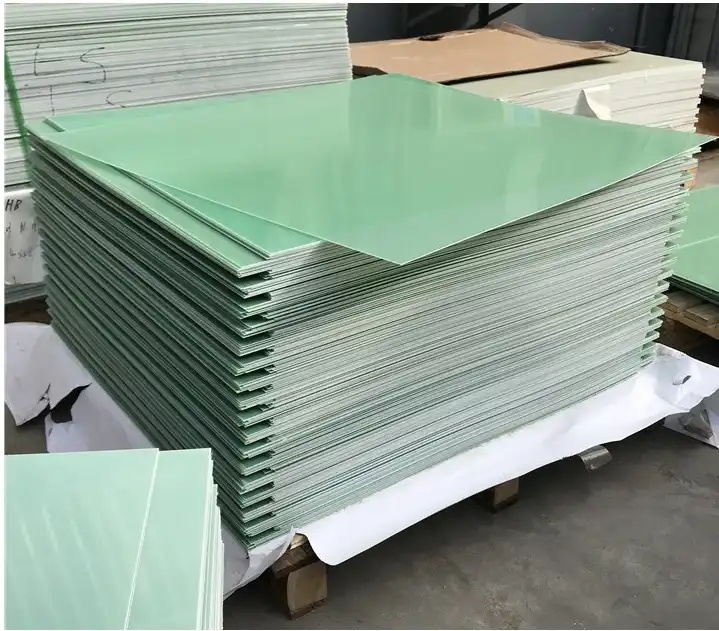What Are the Effects of Moisture on FR4 Sheet Performance?
Degradation of Electrical Properties
Moisture absorption can significantly impact the electrical performance of FR4 sheets. As the material absorbs water, its dielectric constant and dissipation factor may change, leading to altered impedance characteristics and signal integrity issues. This can result in reduced insulation resistance and increased risk of electrical breakdown, compromising the overall reliability of electronic components and circuits built on FR4 substrates.
Mechanical Strength Reduction
Exposure to humidity can weaken the mechanical strength of FR4 sheets. The absorption of moisture can cause swelling and delamination of the material's layers, reducing its structural integrity. This weakening effect may lead to warping, bending, or even fracturing of the FR4 sheet, potentially causing issues during manufacturing processes or in the final product's performance and durability.
Thermal Expansion Concerns
Moisture absorption in FR4 sheets can exacerbate thermal expansion issues. As the material absorbs water, it becomes more susceptible to dimensional changes when exposed to temperature fluctuations. This increased thermal expansion can lead to stress on solder joints, component misalignment, and potential failure of electronic assemblies, particularly in applications subjected to thermal cycling or extreme temperature conditions.
Surface Coating and Storage Techniques for FR4 Protection
Conformal Coating Applications
Applying conformal coatings to FR4 sheets provides an effective barrier against moisture ingress. These thin, protective layers can be made from various materials such as acrylics, silicones, or epoxies. The coating process involves carefully applying the selected material to the FR4 surface, ensuring complete coverage without affecting critical areas like connection points. This protective layer not only guards against humidity but also shields the FR4 sheet from contaminants and environmental stressors, enhancing its long-term reliability and performance.
Vacuum-Sealed Packaging Solutions
Vacuum-sealed packaging offers superior protection for FR4 sheets during storage and transportation. This method involves placing the FR4 sheets in specialized bags or containers and removing air to create a vacuum environment. By eliminating air and moisture from the packaging, vacuum sealing prevents humidity-related issues and preserves the material's properties. This technique is particularly beneficial for long-term storage or when shipping FR4 sheets to regions with varying climate conditions, ensuring they arrive in optimal condition for use.
Climate-Controlled Storage Environments
Maintaining FR4 sheets in a climate-controlled storage environment is crucial for their preservation. Ideal storage conditions typically involve keeping the temperature between 20-25°C (68-77°F) and relative humidity below 50%. Implementing advanced HVAC systems with precise temperature and humidity controls can help achieve these conditions consistently. Additionally, using dehumidifiers or desiccant materials in storage areas can further reduce moisture levels, protecting FR4 sheets from humidity-related degradation over extended periods.
Best Practices for Humidity Control in PCB Manufacturing
Pre-Production Moisture Removal Techniques
Before incorporating FR4 sheets into the PCB manufacturing process, it's essential to implement effective moisture removal techniques. Baking FR4 sheets in specialized ovens at controlled temperatures (typically around 125°C or 257°F) for a specified duration can effectively drive out absorbed moisture. This pre-production step is crucial, especially for FR4 sheets that have been exposed to humid environments during storage or transportation. Implementing a standardized baking protocol ensures consistent moisture removal across all batches, contributing to improved quality and reliability of the final PCB products.
Humidity-Controlled Manufacturing Environments
Creating and maintaining a humidity-controlled environment throughout the PCB manufacturing process is paramount. This involves installing advanced environmental control systems that regulate both temperature and humidity levels in production areas. Ideal conditions typically include maintaining relative humidity between 30-50% and temperatures around 20-25°C (68-77°F). Implementing localized humidity control measures, such as dry boxes or humidity-controlled workstations, can provide additional protection during critical manufacturing stages. Regular calibration and maintenance of these systems ensure consistent environmental conditions, minimizing the risk of moisture-related issues during PCB production.
Post-Production Moisture Barrier Treatments
After the PCB manufacturing process, applying post-production moisture barrier treatments can provide an additional layer of protection for FR4-based circuits. These treatments may include specialized conformal coatings or encapsulation techniques designed to create an impermeable barrier against moisture and other environmental factors. Advanced coating materials, such as parylene or nano-coatings, offer superior moisture resistance while maintaining the electrical properties of the PCB. Implementing these post-production treatments not only enhances the PCB's resistance to humidity but also improves its overall durability and longevity in various operating conditions.
Conclusion
Protecting FR4 sheets from humidity is a multifaceted approach that requires attention to detail throughout the entire lifecycle of the material. By understanding the effects of moisture on FR4 performance, implementing effective surface coating and storage techniques, and following best practices for humidity control in PCB manufacturing, manufacturers can significantly enhance the reliability and longevity of their products. Continuous monitoring, innovative protective measures, and adherence to industry standards are key to maintaining the integrity of FR4 sheets in challenging environments, ultimately leading to higher quality electronic components and systems.
Contact Us
For more information on how to protect your FR4 sheets from humidity or to explore our range of high-quality insulating materials, please contact us at info@jhd-material.com. Our team of experts is ready to assist you in optimizing your manufacturing processes and ensuring the highest standards of quality in your projects.






